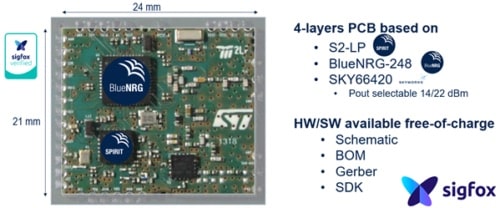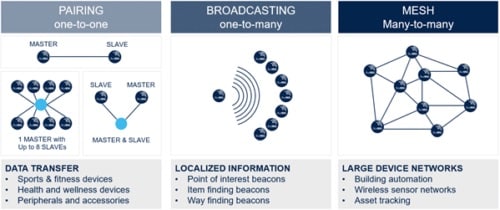According to a study by Statista, a company specialising in market and consumer data, IoT market is expected to reach US$ 1.6 trillion by 2025 from US$ 248 billion in 2020. This meteoric rise is also expected to increase the complexity and versatility of IoT devices in a wide range of use cases.
Choosing the right connectivity option for an IoT device is critical, but often it is not possible to use a single connectivity option for all features in a device. This article highlights the need for optimising the combination of short- and long-range technologies to significantly increase the performance and versatility of the devices.
The article also puts a special focus on Bluetooth Low Energy (BLE) and Sigfox, as they have emerged to become the technology of choice for optimised architectural decisions.
Topology for IoT devices Connectivity
IoT connected devices can be broadly categorised as:
Devices directly connected to long-distance infrastructure
Technologies such as GPRS and CDMA allow our smartphones or IoT devices to connect directly to telecom towers. With the advent of LPWAN technologies such as Sigfox, LoRa and NB-IOT, it is now possible to get a similar connectivity range, but with reduced current consumption and data rate. They allow roaming of IoT connected devices and need not be confined to one particular place.
Devices connected to a local gateway, which in turn is connected to long-distance infrastructure
Wireless technologies such as WiFi or wired technologies such as LAN, IO-Link, PLC etc, allow gateway interfacing with locally connected IoT devices. With this approach, one can connect multiple devices to the Cloud with the help of a single connected gateway. In general, these technologies have a very high data rate and are used for high bandwidth purposes such as Internet browsing, online video or audio etc. The advantage of this approach is that you can remotely control or monitor several devices at your home, office or industry. So, it is also used in many control applications of IoT devices. But as they are dependent on the gateway, they cannot move outside the premises as the first approach.
Devices which are locally connected to a smartphone or with each other – with or without internet connectivity
Technologies such as Bluetooth, Zigbee, Thread and Bluetooth Low Energy (BLE) enable peer-to-peer communication in short distances. In many scenarios, they use a mobile phone as the gateway to the Cloud. The advantage of short-range communication is that they can work independently without any requirement of a Cloud network.
With the advent of Human-Machine Interface (HMI), connected devices such as mobile phones and laptops etc, are normally powered by more than one connectivity technology such as BLE, Bluetooth, WiFi, GPRS etc. However, the majority of IoT devices are designed to execute one particular task, so are connected by only one of the above three approaches. This leads to limitation in the usability, longevity and versatility of those devices.
Optimised Dual Connectivity
An optimised architecture with a combination of long-range technology and short-range technology can be a milestone in the penetration of IoT devices in a wide range of applications.
Long-range connectivity enables communication directly with the communication infrastructure and even allows for roaming. Short-range technology in the same device enables independent short-range communication for a wide range of requirements.

Bluetooth Low Energy (BLE) is an incredible short-range technology, which can complement long-range connectivity technology in a wide range of usage scenarios. BLE can offer short-range direct connectivity in comparison to long-range connectivity that can be given for Cloud connectivity to IoT devices.
Some of the features enabled by BLE for an IoT device are:
User Interface
A BLE connected device can connect to a smartphone app, which in-turn enables the user to interact with the device in an intuitive way. This can also reduce the number of buttons or display needed on device, making it cheaper, lighter and water or dust proof.
Configurability
BLE can also be used to configure the device to act in a certain way. Allowing configurability at user’ end, device maker need not customize the product at the factory. Device can even be configured to range of customized features such as pedometer working as per wearing position, setting alarms or toggle LEDs etc. Even industrial products such as LED drivers can be configured using BLE to suit the type of LED configuration needed by the consumers
Local Monitoring
Presence of BLE-based interfaces enable direct monitoring of sensor data in the absence of Cloud connectivity. This is particularly important where a fast local response is needed. It can also be used to optimise the cost of data as user can decide which data needs to be sent to the Cloud and which one is to be monitored locally
Diagnostic
Often when a device breaks down, the service engineer needs to open the device or connect a cable to get into the device. This is complicated and limits the creativity and features in the device. For example, the device may not be waterproof if it has open ports and can be opened easily by screws. A BLE interface can instead facilitate getting into the device wirelessly in the case of main system failing. In many scenarios, BLE may not be made available to user but activated only for diagnostic purposes.
Firmware Upgrade
Firmware upgrade allows the firmware of a device to get updated after shipping. This is important for providing new features and bug updates even after the device is shipped. By using firmware upgrade, the functionality of a device can also be configured as per the use cases. Firmware upgrade is also an important diagnostic feature.
BLE can be complemented with other long-range technology such as GPRS or LPWAN to offer long-range connectivity. An important and versatile low-power long-range technology is Sigfox. When a BLE SOC drives a Sigfox radio, it can enable wide new features and use cases with a minimal increment in power, form factor and price. Sigfox is a LPWAN technology, which offers global Cloud, long-range connectivity and consumes very low current.
Sigfox devices can freely connect around the world without the need of any separate agreement or roaming charges with network operators.
There are some features, which get activated by implementing long-range technology in the same device. Let us understand the same using Sigfox implementation
Remote Monitoring
Sensor data can be sent to the Cloud using Sigfox network – without the need of local gateways. The device can uplink the data directly to Sigfox gateways operated by Sigfox operators. These gateways can be connected directly up to few kilometres.
Data aggregation
Data from gas meters, water meters or other sensors needs to be aggregated in the Cloud for consolidation, billing or analytics purpose. Sigfox network can be used for this purpose.
Tracking and Positioning
Tracking and positioning is one the most common use case of IoT devices. For accurate positioning requirements, the GPS coordinate can be sent to the Cloud over Sigfox network. Many use cases such as fleet monitoring accept accuracy of few kilometres.
In such use cases, Sigfox network enables positioning using triangulation method without the need of GPS signals. Sigfox has introduced a new feature, called Monarch, to recognise radio service and manage radio frequency changes as per local regulations. Using this feature, a device can roam across national boundaries and still remain connected.
Notification of events
When someone opens a lock using BLE, the information also needs to be recorded on the Cloud using an independent network. Similarly, events such as opening of a door, crossing the threshold of a sensor, burglar alarm, fire alarm etc, need to work independently of local interface. A device powered with right sensors, logic and Sigfox radio can do this with ease
Diagnostic and assistance
An IoT device can raise an alarm over Sigfox network in case it needs assistance or if some part of the device is malfunctioning. Sigfox also allows downlink message to configure device in diagnostic mode and provide relevant data.
STMicroelectronics has introduced a unique solution that combines BLE and Sigfox radio into a common solution. The dual radio offers long-range connectivity via Sigfox and smartphone connectivity using BLE. Smartphone connectivity to Sigfox devices enables User Interface (UI), over the air firmware update (FUOTA) and direct configuration and control.

STDES-MONARCH is Sigfox verified and is provided free of charge with all the necessary design documents and software. This reference design embeds both BlueNRG-2 low-power BLE system-on-chip (SoC) and S2-LP narrow band ultra-low power sub-1GHz transceiver.
The BlueNRG-2 from STMicroelectronics is an ultralow-power BLE 5.0 certified wireless processor, which provides seamless connection with sensors, Privacy 1.2, Secure Connection 4.2, Data Length Extension, 8dBm of output power and a reliable BLE link to IOT devices. Besides, it supports standard fully compliant SIG BLE Mesh.
Mesh connectivity over BLE enables connecting multiple BLE devices in Mesh networks of IOT solutions. Introduction of the Mesh solution has made it possible to connect devices even when they are not in direct range of a network.

The S2-LP is a high performance ultra-low power RF transceiver, intended for RF wireless applications in the sub-1GHz band. It can be programmed to operate at sub-1GHz frequencies in the 413-479 MHz, 452-527 MHz, 826-958 MH or 904-1055 MHz bands. The S2-LP supports different modulation schemes: 2(G)FSK, 4(G)FSK, OOK and ASK. The S2-LP shows an RF link budget higher than 140 dB for long communication ranges and meets the regulatory requirements applicable in territories worldwide, including Europe, Japan, South Asia, India, China and the USA.
As the IoT use cases develop, there will be a need for more connectivity options in the same device. This will enhance usability, versatility and reliability of devices. A combination of BLE SoC driving a sub-1Ghz radio is expected to gain momentum as it brings additional connectivity without compromising on cost, power consumption and form factor. STMicroelectronics has adopted this architecture with two world class radios and expects to witness a huge response from its customers.





